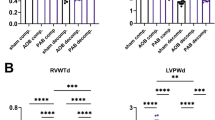Summary
Milrinone, a selective inhibitor of phosphodiesterase (PDE), was examined in neonatal hearts and in ventricular myocytes. Isolated, paced (180 beats/min), isovolumically beating hearts from pigs, <3 days of age, were perfused with an erythrocyte-enriched solution. In one group (control, n=6), milrinone was studied at perfusate concentrations of 1, 10, and 100 μg/ml. In a second group (postischemia, n=10), hearts were subjected to 30 minutes of no-flow ischemic arrest, prior to the addition of milrinone. Left ventricular peak systolic pressure (PSP) and end-diastolic pressure, coronary flow (CF), heart rate (HR), and myocardial oxygen consumption (MVO2) were measured. The PSP averaged ∼100 mmHg during the baseline periods for both groups and decreased to ∼85 mmHg in those hearts subjected to ischemic arrest. In both groups, PSP increased ∼14% at the 1μg/ml concentration of milrinone. No additional increases in PSP were observed in the control group at the higher concentrations. However, PSP increased 28% and 41% (p<0.05), in the postischemia group at the 10 and 100 μg/ml concentrations, respectively. The CF averaged ∼3 ml/min/g during the baseline periods of both groups and increased significantly at each milrinone concentration. The HR in both groups increased to ∼200 and ∼250 beats/min at the 10 and 100 μg/ml concentrations, respectively. Additionally, milrinone's effects in intact hearts were found to be comparable to those of isobutylmethyl xanthine (IBMX), a nonspecific PDE inhibitor. In isolated myocytes, however, milrinone produced only modest increases in cAMP levels, compared to IBMX. We conclude that milrinone has positive inotropic, coronary vasodilatory, and chronotropic effects in the neonatal pig heart. In particular, milrinone also was capable of reversing the contractile dysfunction that resulted when these immature hearts were subjected to 30 minutes of normothermic, no-flow ischemic arrest. Thus, milrinone may be a useful agent in the treatment of neonates with contractile dysfunction.
Similar content being viewed by others
References
Young R, Ward A. Milrinone. A preliminary review of its pharmacological properties and therapeutic use. Drugs 1988;36:158–192.
Evans D. Overview of cardiovascular, physiologic and pharmacologic aspects of selective phosphodiesterase peak III inhibitors. Am J Cardiol 1989;63:9A-11A.
Farah A, Frangakis C. Studies on the mechanism of action of the bypyridine milrinone on the heart. Basic Res Cardiol 1989;84(Suppl I):85–103.
Bull C, Cooper J, Stark J. Cardioplegic protection of the child's heart. J Thorac Cardiovasc Surg 1984;88:287–293.
Binah O, Sodowick B, Vullremoz Y, et al. The inotropic effects of amrinone and milrinone in neonatal and young canine cardiac muscle. Circulation 1986;73(Suppl III): 46–50.
Artman M, Kithas P, Wike J, et al. Inotropic responses to cyclic nucleotide phosphodiesterase inhibitors in immature and adult rabbit myocardium. J Cardiovasc Pharmacol 1989;13:146–154.
Ogawa S-I, Nakanishi T, Kamata K, Takao A. Effect of milrinone on myocardial mechanical function and cyclic AMP content in the fetal rabbit. Pediatr Res 1987;22(3):282–285.
Parrish M, Brannon T, Payne A, et al. Milrinone effects in the isolated immature rabbit heart. Dev Pharmacol Ther 1988;11:328–337.
Becker L, Levine J, Dipaula B, et al. Reversal of dysfunction in postischemic stunned myocardium by epinephrine and postextrasystolic potentiation. J Am Coll Cardiol 1986;7:580–589.
Colucci W. Positive inotropic/vasodilator agents. Cardiol Clin 1989;7(1):131–139.
Liedtke JA, Hughes HC, Neely JR. Metabolic responses to varying restriction of coronary blood flow in swine. Am J Physiol 1975;228,H655-H662.
Ross-Ascuitto N, Ascuitto RJ, Chen V, Downing S. Negative inotropic effects of amrinone in the neonatal pig heart. Circ Res 1987;61:847–852.
Ascuitto RJ, Ross-Ascuitto NT, Chen V, Downing SE. Ventricular function and fatty acid metabolism in neonatal piglet heart. Am J Physiol 1989;256:H9-H15.
Montini J, Bagby GJ, Burns AH, Spitzer JJ. Exogenous substrate utilization in Ca2+ tolerant myocytes from adult rat hearts. Am J Physiol 1981;240:H659-H663.
Shepherd RE, McDonough KH, Burns AH. Mechanism of cardiac dysfunction in hearts from endotoxin-treated rats. Circ Shock 1986;19:371–384.
Brown BL, Albano JD, Ekins RP, et al. A simple and sensitive saturation assay method for the measurement of adenosine 3′:5′ cyclic monophosphate. Biochem J 1971;121: 561–562.
Miller GL. Protein determination for a large number of samples. Anal Chem 1959;31:964.
Ross-Ascuitto NT, Ascuitto RJ, Ramage D, McDonough KH. Mechanical and metabolic function of the neonatal pig heart during low flow ischemia, ischemic arrest and reperfusion (abstract). Pediatr Res 1989;25:244A.
Kusuoka H, Porterfield J, Weisman H, et al. Pathophysiology and pathogenesis of stunned myocardium. Depressed Ca2+ activation of contraction as a consequence of reperfusion-induced cellular calcium overload in ferret hearts. J Clin Invest 1987;75:950–961.
Poole-Wilson P. Regulation of intracellular pH in the myocardium; relevance to pathology. Mol Cell Biochem 1989;89:151–155.
Krause S, Jacobus W, Becker L. Alterations in cardiac sarcoplasmic reticulum calcium transport in the postischemic “stunned” myocardium. Circ Res 1989;65:526–530.
Gwathmey J, Morgan J. The effects of milrinone and piroximone on intracellular calcium handling in working myocardium from the ferret. Br J Pharmacol 1985;85:97–108.
Mahoney L. Maturation of calcium transport in cardiac sarcoplasmic reticulum. Pediatr Res 1988;24:639–643.
Neely J, Grotyohann L. Role of glycolytic products in damage to ischemic myocardium. Circ Res 1984;55:816–824.
Wittnich C, Peniston C, Ianuzzo D, et al. Relative vulnerability of neonatal and adult hearts to ischemic injury. Circulation 1987;76(Suppl V):156–160.
Corbin JD, Sugden PH, Lincoln TM, Keely SL. Compartmentalization of adenosine 3′:5′ monophosphate and adenosine 3′:5′ monophosphate dependent protein kinase in heart tissue. J Biol Chem 1977;252:3854–3861.
Endoh M, Yanasigawat T, Taira N, Blinks JR. Effects of new inotropic agents on cyclic nucleotide metabolism and calcium transients in canine ventricualr muscle. Circulation 1986;76(Suppl III):117–133.
Klitzner T, Shapir Y, Ravin R, Friedman W. The biphasic effect of amrinone on tension development in newborn mammalian myocardium. Pediatr Res 1990;27(2):144–147.
Author information
Authors and Affiliations
Additional information
Grant support has been supplied by The Louisiana Board of Regents, Louisiana Education Quality Support Fund, 150 Riverside Mall, Suite 129, Baton Rouge, LA 70801-1303.
Rights and permissions
About this article
Cite this article
Ross-Ascuitto, N.T., Ascuitto, R.J., Ramage, D. et al. The effects of milrinone in the neonatal pig heart. Cardiovasc Drug Ther 5, 1011–1019 (1991). https://doi.org/10.1007/BF00143529
Issue Date:
DOI: https://doi.org/10.1007/BF00143529




